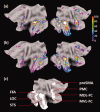Creating probabilistic maps of the face network in the adolescent brain: a multicentre functional MRI study
- PMID: 21416563
- PMCID: PMC6869899
- DOI: 10.1002/hbm.21261
Creating probabilistic maps of the face network in the adolescent brain: a multicentre functional MRI study
Abstract
Large-scale magnetic resonance (MR) studies of the human brain offer unique opportunities for identifying genetic and environmental factors shaping the human brain. Here, we describe a dataset collected in the context of a multi-centre study of the adolescent brain, namely the IMAGEN Study. We focus on one of the functional paradigms included in the project to probe the brain network underlying processing of ambiguous and angry faces. Using functional MR (fMRI) data collected in 1,110 adolescents, we constructed probabilistic maps of the neural network engaged consistently while viewing the ambiguous or angry faces; 21 brain regions responding to faces with high probability were identified. We were also able to address several methodological issues, including the minimal sample size yielding a stable location of a test region, namely the fusiform face area (FFA), as well as the effect of acquisition site (eight sites) and scanner (four manufacturers) on the location and magnitude of the fMRI response to faces in the FFA. Finally, we provided a comparison between male and female adolescents in terms of the effect sizes of sex differences in brain response to the ambiguous and angry faces in the 21 regions of interest. Overall, we found a stronger neural response to the ambiguous faces in several cortical regions, including the fusiform face area, in female (vs. male) adolescents, and a slightly stronger response to the angry faces in the amygdala of male (vs. female) adolescents.
Copyright © 2011 Wiley Periodicals, Inc.
Figures















References
-
- Akiyama T, Kato M, Muramatsu T, Saito F, Umeda S, Kashima H ( 2006): Gaze but not arrows: A dissociative impairment after right superior temporal gyrus damage. Neuropsychologia 44: 1804–1810. - PubMed
-
- Beauchamp MS, Lee KE, Haxby JV, Martin A ( 2003): FMRI responses to video and point‐light displays of moving humans and manipulable objects. J Cogn Neurosci 15: 991–1001. - PubMed
-
- Benton A ( 1990): Facial recognition. Cortex 26: 491–499. - PubMed
Publication types
MeSH terms
Grants and funding
LinkOut - more resources
Full Text Sources

